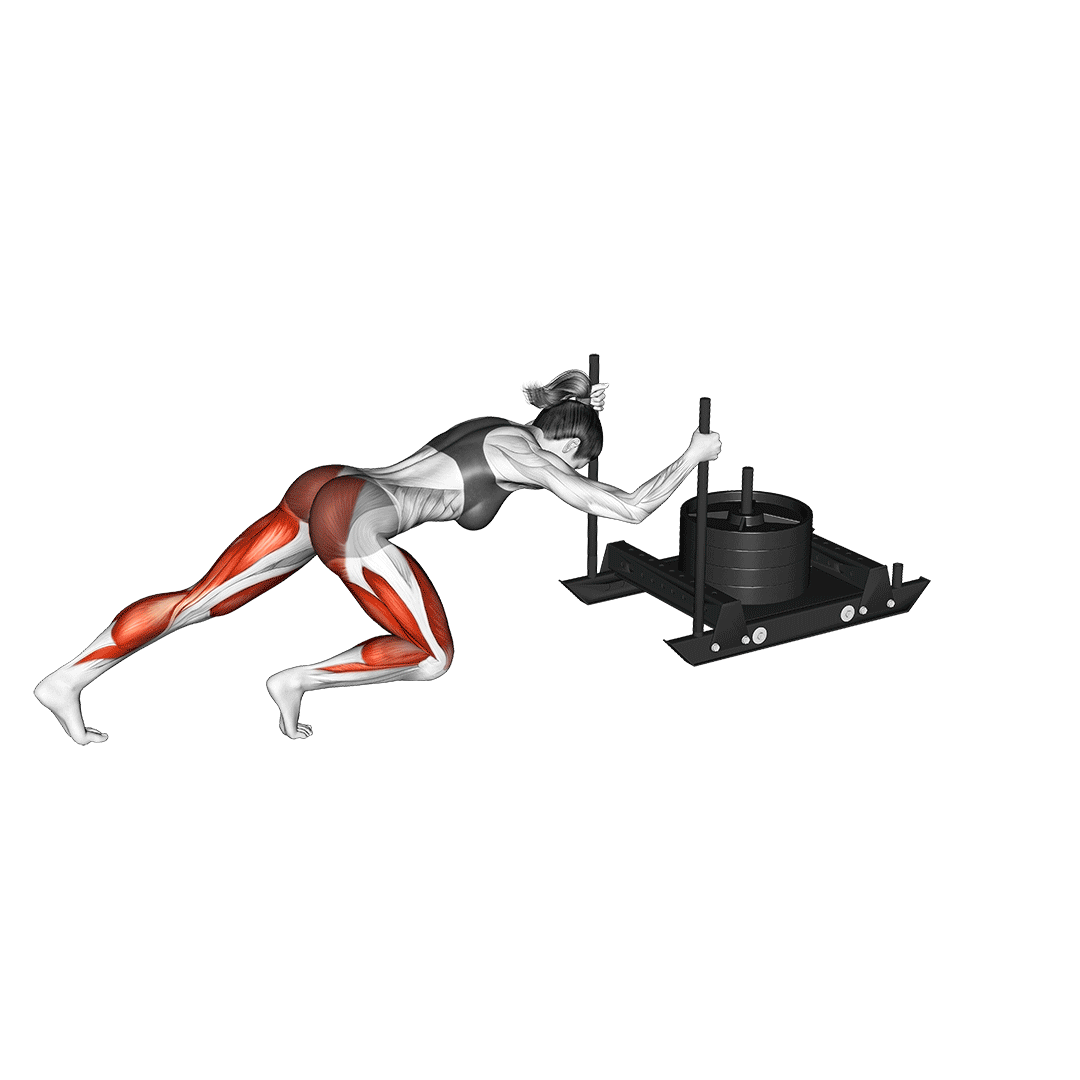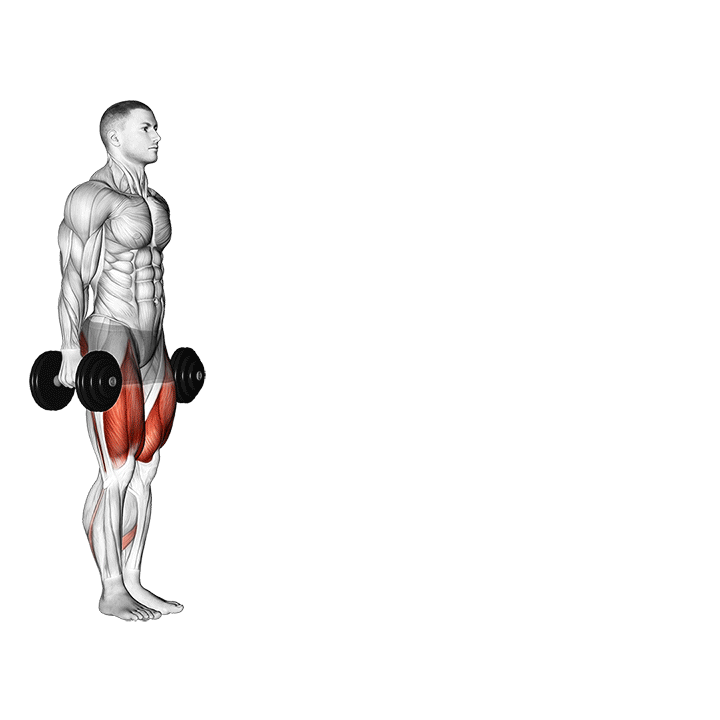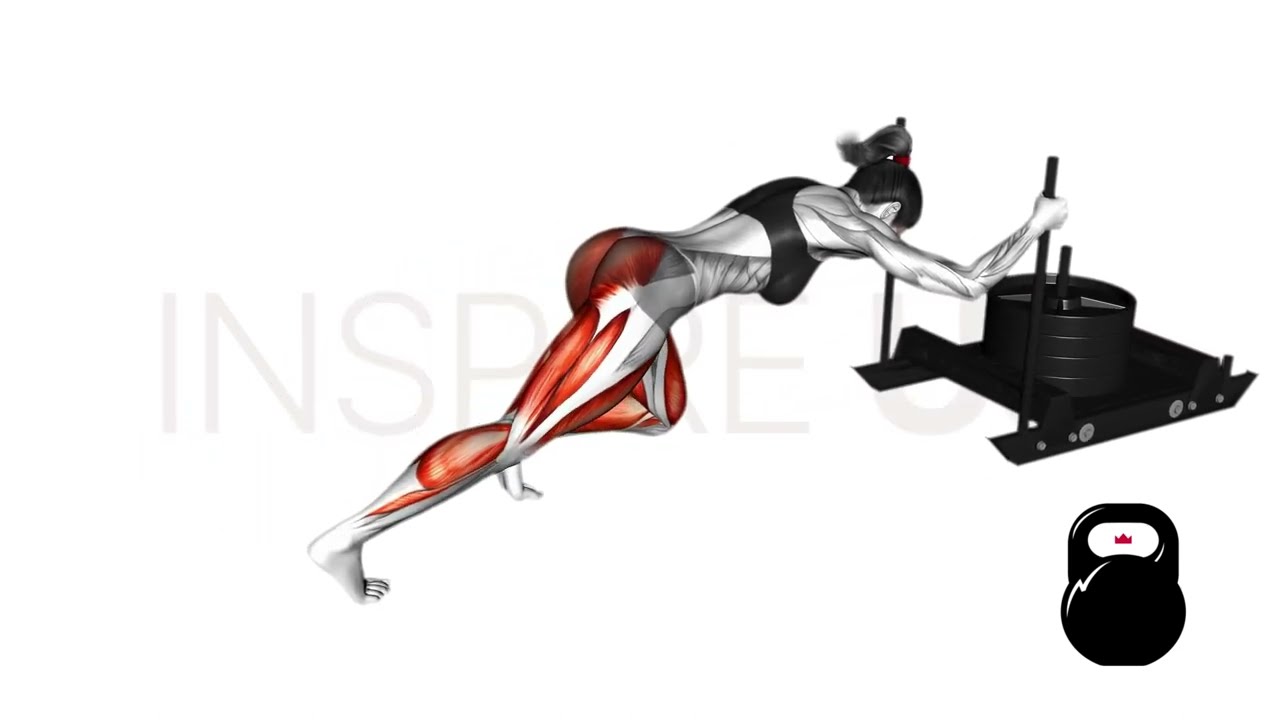Sled Push: Benefits, Muscles Worked, and More
The sled push is a highly versatile full-body exercise that trains not only muscular strength, but also speed, conditioning and general athleticism.
Below, the sled push will be discussed in detail, covering aspects like how to perform it, what muscles it targets and the large number of benefits it offers.
What is the Sled Push Exercise?
In technical definition, the sled push is classified as an open chain compound exercise of moderate difficulty. As the name implies, the sled push involves the lifter pushing a weighted sled for a predetermined length of time or distance.

Because of how versatile the sled push is, exercisers of all types include it in a variety of different training programs. Most notably, sled pushes are used for developing full-body athleticism and composition.
Is the Sled Push the Right Exercise for You?
With the versatility of the sled push, it is far easier to determine whether it’s the wrong exercise for you.
If your training goals require slow and heavy resistance - or a more isolated form of muscular recruitment - then the sled push may not be the right exercise to choose.
However, if you wish to build full body power, endurance or speed, the sled push is the perfect finishing exercise for you.
Programming the Sled Push
Sled pushes are not measured in repetitions, as is the case with other weighted exercises. Instead, each set is measured by the distance with which the sled is pushed, or for how long a length of time.
Whether you are measuring by distance or time will depend on your specific goals. For strength and endurance, time is preferred; For power and speed, time is used.
How to Sled Push Correctly
In order to perform the sled push correctly, the lifter will place both their hands high along the handles of the sled. The body should be bent at the hips at an angle between 45 and 90 degrees, core braced to protect the spine.
From this stance, the lifter will then push through the palms of their hands and take a large step forwards, ensuring that the heels are off the ground and the knees bent as they do so.
To complete the sled push, the lifter need only maintain this movement pattern and continue to push the sled forwards until they’ve reached the finishing time (or distance).
Note that the position of the hands along the sled will directly alter the incline of the torso. This means that a lower position creates a more horizontal torso angle, potentially increasing the strain on the back.
What Muscles do Sled Pushes Work?
Sled pushes work practically every single muscle found in the body.

However, not all are recruited to the same extent. Muscles that are contracted dynamically are referred to as “mover” muscles. In contrast, those that are used solely in a static capacity are called stabilizer muscles.
Primary Mover Muscles
Although the majority of the body plays a role during a sled push set, it is the muscles of the glutes, quadriceps and calves that are most pivotal.
These three aforementioned muscles receive the most development from sled pushes, and are recruited throughout the entire movement pattern.
Secondary Mover Muscles
Apart from the primary mover muscles, those of the hamstrings, triceps, pectorals, hip flexors and deltoids also play a dynamic role.
Unlike the primary movers, the secondary movers are not utilized in the same intensity or range, but nonetheless feature dynamic contraction.
Stabilizer Muscles
Depending on the angle of the torso, the erector spinae, abdominals and obliques are all utilized isometrically. Generally, a more horizontal torso equates to greater stabilizer muscle contraction.
What are the Benefits of Doing Sled Pushes?
With how much of an all-around solid exercise the sled push is, we’ve condensed its numerous benefits into the following 6 below.
Excellent for Lower Body Muscular Development
Although the sled push is not solely a lower body exercise, much of the force used to perform it requires significant contraction of the leg muscles.
When programmed appropriately, this sort of contraction will result in significant muscular development - not only in terms of mass, but also in strength, speed and endurance.
In particular, the quadriceps and gluteal muscles receive the most benefit from sled pushes.
Builds Full-Body Explosiveness, Speed and Endurance
The sled push is capable of imparting significant improvements in speed, explosiveness and endurance throughout the entire body.
While muscular development is partially responsible for these improvements, other factors like cardiovascular system improvements and greater bodily coordination are also contributing factors.
Sled pushes are particularly useful as a finishing exercise in power training drills or similar types of workouts. Using the sled push in such contexts will allow athletes to squeeze out that last bit of training stimulus in a manner that targets the entirety of the body effectively.
Highly Versatile and Multi-Purpose
Simply altering how much weight is placed on the sled - or for how long it is pushed - can allow the performer to change the purpose of the sled push.
Longer durations or distances with less weight produce a more endurance-focused training stimulus, whereas shorter durations performed as rapidly as possible are better for the development of explosiveness and power.
The sled push can be modified for practically any training goal, even those of a more specific nature such as reinforcement of lower body coordination or bodily recomposition. We advise starting out with a low level of intensity and slowly working your way towards a sled push that fits your needs.
One of the Best Athletic Exercises Available
Burpees, sprints and mountain climbers are just a few highly effective exercises ideal for athletes of all sorts - of which are comparable to the sled push in terms of athletic skill development.
Regardless of whether the athlete is a martial artist, powerlifter or marathoner, the sled push has something to offer.
As mentioned in the previous entry of this list, the sled push can be modified so as to fit the training needs of the performer.
This includes the development of more sports-specific capabilities, such as significant pushing power or the development of lower body muscular endurance without significant cardiovascular stress.
With how intense and fatiguing the sled push can be, remember to place it among the last exercises in your athletic training sessions.
Effective for Caloric Expenditure
It should be no surprise that a highly intense exercise involving the entirety of the body is energy-intensive. Even a few short sets of sled pushes can torch quite a few calories. This can be especially useful for people who want to stay off the treadmill.
If fat burning is your goal, it may be best to lower the amount of weight loaded onto the sled.
Instead, aim for a longer duration with each set, and aim to keep the intensity at a moderate yet steady pace all throughout.
Can Function as Cardio
Although nowhere near as cardiovascularly demanding as running or swimming, the sled push can be quite effective as a form of cardio as well. Weightlifters or athletes pressed for time can get both their aerobic and anaerobic training in with only a single exercise - that being the sled push.
Common Sled Push Mistakes to Avoid
While sled pushes are pretty easy to master, there are still a few highly common mistakes that even seasoned athletes are prone to making.
Rounding the Back or Misaligning the Spine
Perhaps the biggest mistake made when doing a sled push is allowing the spine to curve.
A poorly oriented spine is usually a sign of the core musculature not being contracted correctly, and can easily result in injury if left uncorrected. This is especially important in regards to the lower back.
In order to ensure that the sled push is performed as safely as possible, firmly contract the core muscles and ensure that the spine is kept in a neutral alignment throughout the exercise.
Exercisers having trouble doing so may need to adopt a less horizontal torso angle, or otherwise practice proper spine positioning.
Driving With the Upper Body
Although the upper body does indeed play an important role during the sled push, the majority of the force should be derived from the lower body. Not only is this more efficient and allows for greater weight to be moved, but doing so also ensures that no injuries occur.
Athletes who find that their back, triceps or shoulder muscles begin to fatigue far earlier than their lower body may be over-utilizing said musculature.
A good way to correct this is to have the athlete focus on driving with their knees and calves. This ensures that the lower body contracts first, and bears the brunt of the resistance of the exercise.
Failing to Contract the Core
As mentioned previously, poor core muscle recruitment can result in the lower back or spine being at risk of injury. However, poor contraction of the core itself is also a common mistake - one that also leads to a host of further issues, spinal safety notwithstanding.
A commonly used cue to ensure abdominal contraction is to imagine “pulling your navel towards your spine”. This helps the exerciser consciously squeeze their core.
Failing to Engage the Calf Muscles
Individuals more familiar with traditional weightlifting may find the inclusion of dynamic calf muscle contraction to be against their instincts.
Unlike with back squats or deadlifts however, the sled push requires proper calf engagement to perform properly. Certain coaches even advise performing the exercise entirely on the forefoot, with the heels never touching the ground during the set.
While it is ultimately up to personal preference, there is no denying that launching off the floor with the calves is vital to pushing a weighted sled correctly. Keeping the movement entirely knee-driven will make it more difficult than is necessary, and negate potential calf muscle development.
Alternatives to the Sled Push
Are sled pushes not quite the exercise you need? Try out the three following alternatives we’ve listed below.
Sled Pulls
For greater recruitment of the posterior musculature, switching from sled pushes to sled pulls is the ideal choice.
As the name implies, sled pulls involve pulling the sled along with you, rather than pushing it forwards. This is often made easier with attached resistance bands or ropes that allow for a more neutral orientation of the arms.
Rather than using sled pulls as an alternative, it is also entirely possible to perform both sled pulls and pushes together for a more comprehensive full-body workout.
Plate Pushes
If you don’t have access to a training sled but want to recreate the same benefits and muscular recruitment, the plate push is the next best thing.
Plate pushes involve placing a weight plate on a surface of suitable traction, with the lifter bending at the hips and knees as they push the plate in a bent-over position. While considerably lower than most sled push sets, this exercise works much the same musculature in a similar movement pattern.
Dumbbell Walking Lunges
For a similarly dynamic and leg-focused alternative to the sled push, performing walking lunges with dumbbells or kettlebells may be the right substitute.

Although significantly less upper body recruitment takes place, dumbbell walking lunges recreate the same lower body movements and muscular recruitment as sled pushes. With this shared set of lower body mechanics, dumbbell walking lunges are ideal for lifters who wish to avoid working their upper body.
Frequently Asked Questions (FAQ)
Is Sled Pushing Good?
Yes - sled pushing is excellent for building power, torching calories and raising your heart rate all in a single highly intense exercise.
Are Sled Pulls Different From Sled Pushes?
Sled pulls involve drawing the sled along with you as you walk, whereas sled pushes are done by pushing the sled forwards.
This changes which muscles are focused on by either exercise, with sled pushes targeting the anterior section of the body more, and sled pulls the posterior section.
Are Sled Pushes Better Than Squats?
In certain aspects, yes.
Sled pushes are considerably more dynamic and aerobically-intensive than squats, but may not recruit the glutes and quadriceps to the same extent. Furthermore, sled pushes are better for building up endurance and speed - whereas squats are better for building up gross strength and mass.
Parting Advice
The sled push is an invaluable inclusion into any athletic training program, and can help you lose weight, develop power or even build strength in the right circumstances.
Remember to program it according to your specific training goals - and to ensure proper form is followed at all times. Avoid curving the lower back or excessive usage of your upper body to push the sled.
References
1. Cahill, Micheál & Cronin, John & Oliver, Jon & Clark, Kenneth & Cross, Matt & Lloyd, Rhodri. (2019). Sled Pushing and Pulling to Enhance Speed Capability. Strength and Conditioning Journal. 41. 1. 10.1519/SSC.0000000000000460.
2. Cahill, Micheál & Oliver, Jon & Lloyd, Rhodri & Cronin, John & Clark, Kenneth & Cross, Matt. (2020). Influence of resisted sled-push training on the sprint force-velocity profile of male high school athletes. Scandinavian Journal of Medicine and Science in Sports. 30. 10.1111/sms.13600.
3. Hoffmann, James Jr, "An Investigation of the Sled Push Exercise: Quantification of Work, Kinematics, and Related Physical Characteristics" (2014). Electronic Theses and Dissertations. Paper 2422. https://dc.etsu.edu/etd/2422

